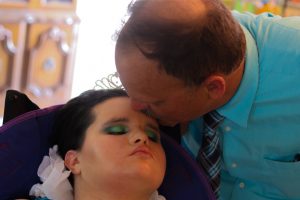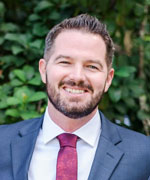Pediatric Hospice Care Helps Family Feel Whole Again
Prom night for Starlynn Barnes had all the makings of a typical high school formal. The then-17-year-old had her hair and makeup done, wore a sequin dress, and took photos with her family. But Star, a pediatric hospice patient, wasn’t going to her high school prom. This prom was put on by St. Joseph’s Children’s Hospital. An annual gathering for kids and teens who couldn’t go to their own prom due to hospitalization or chronic or life-threatening illnesses.
Star has a rare brain disease called Moyamoya, which is caused by blocked arteries at the base of the brain.
She was diagnosed with neurofibromatosis since before she was even two-years-old. It’s a genetic disorder that affects how nerve cells form, sometimes causing tumors to grow on nerves.
Her Moyamoya disease wasn’t discovered until January of this year.
That’s when Star’s step-mom Laura found her having a seizure on the bathroom floor. A trip to the emergency room revealed it was much more than a seizure. Doctors discovered Star had bleeding on her brain and was rushed into surgery.
The neurologist who performed the procedure had specialized in Moyamoya disease, but had never seen a child have it on both sides of the brain. Star was the most severe case he’d ever seen.
Her seizures were so frequent, doctors had to perform three surgeries before she stabilized.
“Her doctor came out after surgery and said it was like he opened up her brain, and her brain said ‘here I am, fix me,” Laura said. “There was a little part in the back of our minds that thought she wasn’t going to survive surgery because she was in such bad shape.”
Star was alive, but unresponsive. She was in intensive care for about a month when she developed an infection. She had to have another surgery to remove part of a bone flap over her brain. An MRI revealed she had more strokes. Nearly every part of her brain had been affected.
After a few months at St. Joseph’s, it was time for Star’s family to make a decision. The hospital staff had done all they could for Star and presented them with two options: Bring her to a nursing home, or care for her at home with the help of LifePath Hospice.
They opted for a nursing home, but Star’s stay didn’t last long. After multiple fevers and a trip back to the emergency room, Laura and Stephen decided it was time to bring Star home where they could keep a closer eye on her.
“We were apprehensive,” Stephen said. “We thought, ‘can we do the job of giving her medicine, changing her, bathing her?”
Pediatric Hospice Care to the Rescue
What they found with LifePath Hospice was support they had never imagined was possible.
 “I didn’t realize how many resources we had available to us,” Stephen said. “LifePath Hospice has just been so on top of everything.”
“I didn’t realize how many resources we had available to us,” Stephen said. “LifePath Hospice has just been so on top of everything.”
“There were times where we were at the hospital so much that our other kids felt like they didn’t even have parents,” Laura said. “When we got to bring her home, our family was whole again.”
Star returned to the comfort of her home under pediatric hospice care in April. She hasn’t been back to the hospital since. That was until prom night at St. Joseph’s.
LifePath Hospice was able to provide Star’s dress, and found volunteers for her hair and makeup. AMR Transportation also donated their resources to make sure Star had a safe ride to and from the event.
For Laura and Stephen, it was the first time their family was able to have a night out in nearly five months.
“I didn’t want it to end,” Laura said. “Just to see the kids out there smiling and happy. It’s been a long time.”
Making the Decision to Put Your Child on Hospice Care
Stephen and Laura Barnes know it can be scary to think what hospice care can mean for a child, but they want other parents to know that it doesn’t have to mean the worst.
“Don’t think you’re taking your child home to die,” Stephen said. “You’re taking them home to be surrounded by love.”
Like many other parents, the Barnes had rearranged their lives to become caregivers, which they admit seemed overwhelming at first.
“Some people told us we didn’t know what we were getting ourselves into with hospice,” Stephen said. “It’s 24/7, it’s a lot of work.”
Thanks to the resources LifePath Hospice provides, they said it isn’t as hard as they thought it would be.
“If you’re in the hospital and you want to take your child home, there’s help out there,” Laura said. “You’re not going to be doing it alone.”
Raising Awareness to Help Catch Moyamoya Disease Early
Moyamoya disease has no cure, but if detected early enough, can be managed to help avoid strokes and live a healthy life.
Unfortunately for Star, it wasn’t caught until she had a stroke.
She had shown a few signs before then, but nothing that tipped doctors off to Moyamoya disease.
“You’re not going to know you have it unless you specifically look for it,” Stephen said. “Or if something like a stroke happens.”
Word has since spread since Star’s diagnosis, and Laura believes her story has helped doctors catch the disease in at least two other children, likely avoiding an eventual stroke.
In one case, a young girl went to see a pediatrician with similar symptoms that Star had dealt with when she was younger. That doctor also happened to be Star’s pediatrician, and recognized the symptoms, discovering the disease before it caused any serious damage.
In another case, a family friend had mentioned Star’s condition to her coworkers, and the symptoms sounded too familiar to one. She took her son to the doctor and they were also able to catch the disease early.
At Chapters Health System and its affiliates—Good Shepherd Hospice, HPH Hospice and LifePath Hospice, every day is devoted to educating our patients and keeping them in the place they call home. We are dedicated to ensuring that patients, young and old alike, and their families are able to make educated decisions about important healthcare matters. For more information, please call our helpful Chapters Health team at 1.866.204.8611 or send an email to info@chaptershealth.org.
Pat Carragher, Media Relations Coordinator for Chapters Health System, coordinates external communications for the not-for-profit organization.
Chapters Health System Pediatric Services
Our pediatric programs serve three distinct populations of children: those with chronic or complex conditions who require palliative care, those with serious conditions who are not yet eligible for hospice and those needing end-of-life care.
- Rare congenital diseases
- Birth traumas
- Chromosome or genetic diseases, such as Trisomy 13 or 18
- Neurological or seizure disorders, such as severe cerebral palsy
- Cancer
- And many others
An important goal of the pediatric programs is helping families access services at every stage of their medical journey, with an emphasis on keeping the family unit functioning as normally as possible.
The children in Chapters Health’s pediatric programs may require different services at different times during the course of their illnesses. With the pediatric programs being so comprehensive, patients can easily transition between levels of care. For instance, if children need help with symptom management or better treatment tolerance for their illnesses, they can receive palliative care services through Partners in Care (PIC) in Hardee, Highlands, Hillsborough and Polk counties.
Under Chapters Health pediatric programs, the team includes:
- Physicians
- Nurse practitioners
- Nurses
- Social workers
- Chaplains
- Hospice aides
They work together as a team with a focus not just on the patient but the entire family, including healthy siblings.
